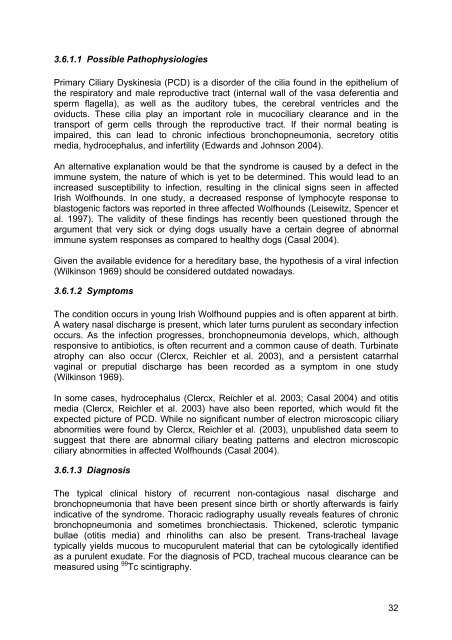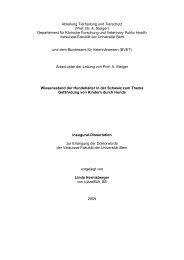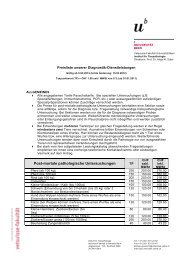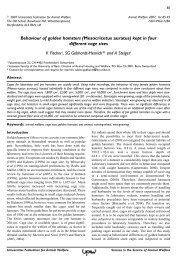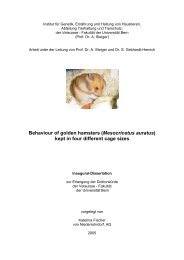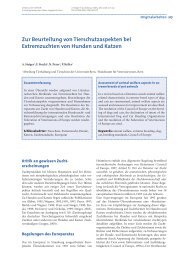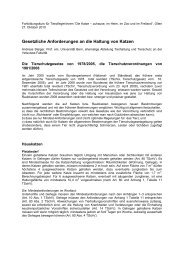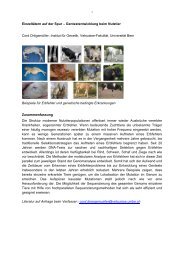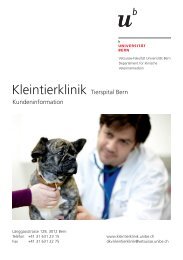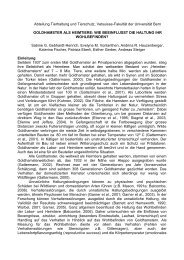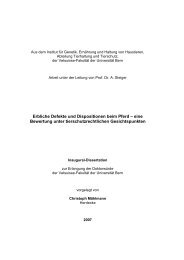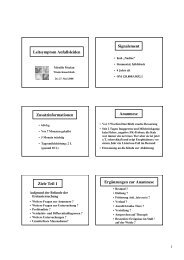Lifespan and Causes of Death in the Irish Wolfhound - Vetsuisse ...
Lifespan and Causes of Death in the Irish Wolfhound - Vetsuisse ...
Lifespan and Causes of Death in the Irish Wolfhound - Vetsuisse ...
Create successful ePaper yourself
Turn your PDF publications into a flip-book with our unique Google optimized e-Paper software.
3.6.1.1 Possible Pathophysiologies<br />
Primary Ciliary Dysk<strong>in</strong>esia (PCD) is a disorder <strong>of</strong> <strong>the</strong> cilia found <strong>in</strong> <strong>the</strong> epi<strong>the</strong>lium <strong>of</strong><br />
<strong>the</strong> respiratory <strong>and</strong> male reproductive tract (<strong>in</strong>ternal wall <strong>of</strong> <strong>the</strong> vasa deferentia <strong>and</strong><br />
sperm flagella), as well as <strong>the</strong> auditory tubes, <strong>the</strong> cerebral ventricles <strong>and</strong> <strong>the</strong><br />
oviducts. These cilia play an important role <strong>in</strong> mucociliary clearance <strong>and</strong> <strong>in</strong> <strong>the</strong><br />
transport <strong>of</strong> germ cells through <strong>the</strong> reproductive tract. If <strong>the</strong>ir normal beat<strong>in</strong>g is<br />
impaired, this can lead to chronic <strong>in</strong>fectious bronchopneumonia, secretory otitis<br />
media, hydrocephalus, <strong>and</strong> <strong>in</strong>fertility (Edwards <strong>and</strong> Johnson 2004).<br />
An alternative explanation would be that <strong>the</strong> syndrome is caused by a defect <strong>in</strong> <strong>the</strong><br />
immune system, <strong>the</strong> nature <strong>of</strong> which is yet to be determ<strong>in</strong>ed. This would lead to an<br />
<strong>in</strong>creased susceptibility to <strong>in</strong>fection, result<strong>in</strong>g <strong>in</strong> <strong>the</strong> cl<strong>in</strong>ical signs seen <strong>in</strong> affected<br />
<strong>Irish</strong> <strong>Wolfhound</strong>s. In one study, a decreased response <strong>of</strong> lymphocyte response to<br />
blastogenic factors was reported <strong>in</strong> three affected <strong>Wolfhound</strong>s (Leisewitz, Spencer et<br />
al. 1997). The validity <strong>of</strong> <strong>the</strong>se f<strong>in</strong>d<strong>in</strong>gs has recently been questioned through <strong>the</strong><br />
argument that very sick or dy<strong>in</strong>g dogs usually have a certa<strong>in</strong> degree <strong>of</strong> abnormal<br />
immune system responses as compared to healthy dogs (Casal 2004).<br />
Given <strong>the</strong> available evidence for a hereditary base, <strong>the</strong> hypo<strong>the</strong>sis <strong>of</strong> a viral <strong>in</strong>fection<br />
(Wilk<strong>in</strong>son 1969) should be considered outdated nowadays.<br />
3.6.1.2 Symptoms<br />
The condition occurs <strong>in</strong> young <strong>Irish</strong> <strong>Wolfhound</strong> puppies <strong>and</strong> is <strong>of</strong>ten apparent at birth.<br />
A watery nasal discharge is present, which later turns purulent as secondary <strong>in</strong>fection<br />
occurs. As <strong>the</strong> <strong>in</strong>fection progresses, bronchopneumonia develops, which, although<br />
responsive to antibiotics, is <strong>of</strong>ten recurrent <strong>and</strong> a common cause <strong>of</strong> death. Turb<strong>in</strong>ate<br />
atrophy can also occur (Clercx, Reichler et al. 2003), <strong>and</strong> a persistent catarrhal<br />
vag<strong>in</strong>al or preputial discharge has been recorded as a symptom <strong>in</strong> one study<br />
(Wilk<strong>in</strong>son 1969).<br />
In some cases, hydrocephalus (Clercx, Reichler et al. 2003; Casal 2004) <strong>and</strong> otitis<br />
media (Clercx, Reichler et al. 2003) have also been reported, which would fit <strong>the</strong><br />
expected picture <strong>of</strong> PCD. While no significant number <strong>of</strong> electron microscopic ciliary<br />
abnormities were found by Clercx, Reichler et al. (2003), unpublished data seem to<br />
suggest that <strong>the</strong>re are abnormal ciliary beat<strong>in</strong>g patterns <strong>and</strong> electron microscopic<br />
ciliary abnormities <strong>in</strong> affected <strong>Wolfhound</strong>s (Casal 2004).<br />
3.6.1.3 Diagnosis<br />
The typical cl<strong>in</strong>ical history <strong>of</strong> recurrent non-contagious nasal discharge <strong>and</strong><br />
bronchopneumonia that have been present s<strong>in</strong>ce birth or shortly afterwards is fairly<br />
<strong>in</strong>dicative <strong>of</strong> <strong>the</strong> syndrome. Thoracic radiography usually reveals features <strong>of</strong> chronic<br />
bronchopneumonia <strong>and</strong> sometimes bronchiectasis. Thickened, sclerotic tympanic<br />
bullae (otitis media) <strong>and</strong> rh<strong>in</strong>oliths can also be present. Trans-tracheal lavage<br />
typically yields mucous to mucopurulent material that can be cytologically identified<br />
as a purulent exudate. For <strong>the</strong> diagnosis <strong>of</strong> PCD, tracheal mucous clearance can be<br />
measured us<strong>in</strong>g 99 Tc sc<strong>in</strong>tigraphy.<br />
32


